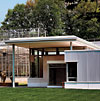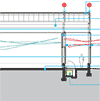Commercial Buildings Open Their Windows
Two buildings, 10 years apart
The RWE Tower in Essen, Germany, is acknowledged to be the first contemporary high-rise to be naturally ventilated. It was completed in 1996 and remains a model of energy efficiency and excellent design. Built as the headquarters for an energy company, the architect, Ingenhoven Overdeik Kahlen & Partners, and the engineer, Buro Happold, developed the design based on their runner-up entry in the Commerzbank competition. "The Commerzbank competition entry was a building in a ‘shroud' that could breathe. We explored how to provide conditions that people want and systems that would make high-rises more environmentally friendly," says Buro Happold partner Tony McLaughlin. "We built on the principle of the ‘air path' used in the Empire State Building to reduce the pressure differential when the windows are opened."
The RWE Tower is a 29-story, 394-foot circular tower with a double-skin facade. The external layer is permeable, drawing in and exhausting air through horizontal bands of openings that alternate at each floor. The openings, developed by German curtain-wall manufacturer Josef Gartner and Company and nicknamed "fish mouths" because of their profile, were sized according to Computational Fluid Dynamics (CFD) analysis around the building during peak conditions. [CFD is a method of modeling air distribution; see record, September 2003, page 165.] The "fish mouths" not only provide ventilation, but prevent driving rain from entering the building, and restrict vertical sound transmission through the cavity. The interior layer is permeable, as well, with user-controlled panels that slide open to allow the mouths to breathe.
The outer skin is made up of clear, toughened, single sheets of glass that increase the daylight available to the interior. Clear glass for better daylighting is used in conjunction with remotely operated aluminum blinds for sun protection, which are located in the 20-inch facade cavity. The circular plan was also chosen to increase the opportunity for occupants to be near daylight, by organizing the floor plan into relatively small units of enclosed space, which are generally no more than 23 feet deep from window to interior wall.
"The building has a displacement ventilation system with a chilled ceiling [perforated-metal ceiling tiles with tubing through which chilled water passes instead of forced air through ducts], which can handle cooling for the entire building during periods when the outside air is too uncomfortable," explains McLaughlin. It is designed to work in conjunction with the natural system, shutting off, for example, when it detects that someone has opened a window within a zone. It is also designed to monitor outside wind speeds and to sound a warning when they exceed certain limits, to signal occupants to close the windows. The controls are immensely flexible in their ability to respond to changing needs or habits with centralized or decentralized operation of blinds, openings, and the mechanical system. User responsiveness is relatively simple in this case, because the building has a single owner/tenant.













